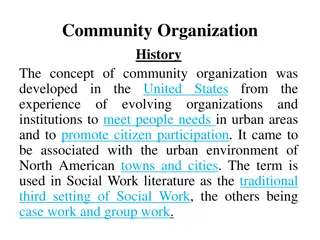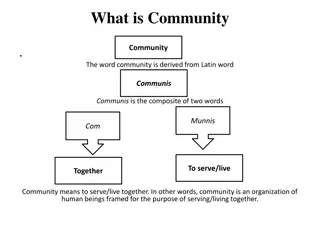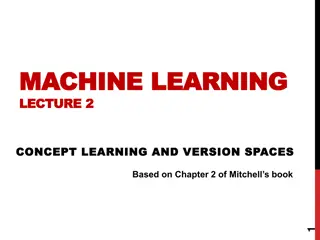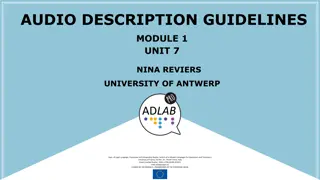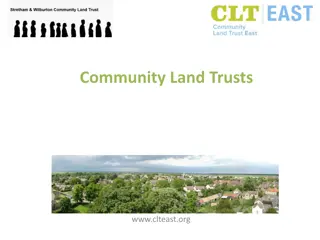Understanding the Concept of Community: Definition, Description, and Elements
The concept of community, derived from the Latin word "Commune," signifies a group of people who share common modes of communication, language, habits, and more. Sociologists have various definitions, with common elements being locality, community sentiment, and a shared culture. Communities are classified into types like rural, urban, and virtual, each with unique characteristics and social structures.
Download Presentation

Please find below an Image/Link to download the presentation.
The content on the website is provided AS IS for your information and personal use only. It may not be sold, licensed, or shared on other websites without obtaining consent from the author. Download presentation by click this link. If you encounter any issues during the download, it is possible that the publisher has removed the file from their server.
E N D
Presentation Transcript
Definition & Description of Community
The concept of community is derived from the Latin word Commune which means to communicate. Accordingly by community is meant such a group of people between whom there is common mode of communicating with one another. There is similarity in their language, habits, customs, means of livelihood, conditions and characteristics of the life. In sociological literature there are a number of definitions of the term community depending upon the social scientists, authors and knowledgeable writers and their focus of attention on special problem. But still the term community is undergoing the stages of qualification and modification.
Anyhow for the sake of reference, we can say that the concept of community refers to: A large number of people living together within a specific geographical area, sharing a common way of life in such a way, that they try to overcome most of their basic needs and problems from local resources and institutions. (Or) According to Ogburn & Nimcoff, A community may be thought of as a total organization of social life within a limited area. (Or) According to Maciver, Community is an area of social living marked by some degree of social coherence. He further says, Whenever the members of any group, small or large, living together in such a way that they share, not this or that particular interest, but the basic conditions of common life, we call that group a community.
Elements of Community: The basic elements of a community are: i) Locality: As for locality, a community occupies a specific territorial area to reside. It means the condition for a group to be a community is that they live together in a specific geographical boundary that provides them almost all the means of subsistence. ii) Community Sentiment: The community sentiment refers to the social coherence which community people inculcate within themselves. However, every community usually has two types of sentiments which are not found in other groups. Firstly, a sense of belonging to its territory, and secondly, a sense of belonging to one another.
iii) Common Culture: The community people share a common culture. They have their own cultural norms which are shared by the community as a whole. These local norms are the product of their local social conditions and are different and more important than those of general community.
Types of Community: Communities are usually classified into three important types: Rural Community: Rural community is a natural phenomenon. It is present in almost every society of the world and is characterized by low population rate, simple culture, informal social life, high degree of homogeneity and lack of modern facilities. Urban Community: Urban community is opposite to rural community. In this type people live in large numbers and have highly impersonal relationships with each other along with high degree of complexity and heterogeneity in their living style. It is a product of rational choice and has all the modern facilities.
Tribal Community: According to Oxford Dictionary, A tribe is a group of people in a primitive or barbarous stage of development acknowledging the authority of a chief and usually regarding themselves as having a common ancestor. Whereas L.M communities are those which are small in scale, are restricted in the spatial and temporal range of their social, legal and political relations and possess a morality, a religion and world view of corresponding dimensions. Lewis believes that tribal
Conclusion: This concept of community is of great importance particularly in developing countries where the resources are very limited with respect to their problems and needs. There it becomes very difficult for the government to meet individuals problems one by one, therefore, it takes them at community level so that more and effective results could be achieved in a short time.












